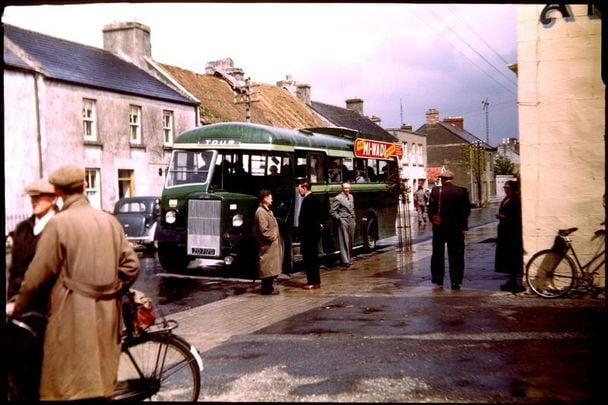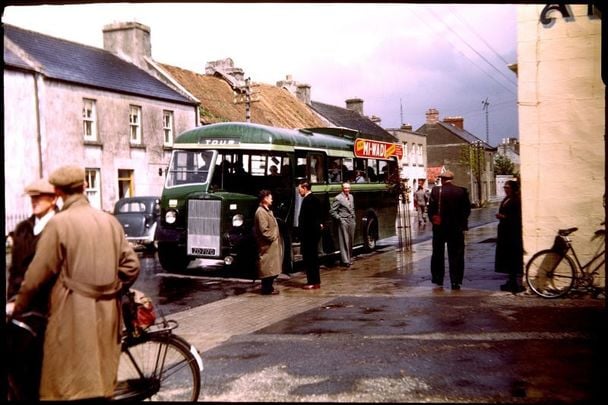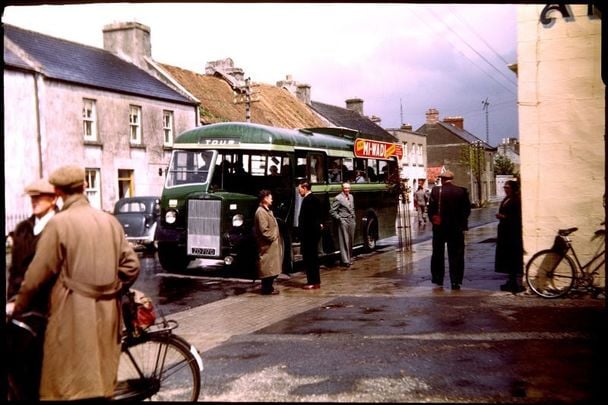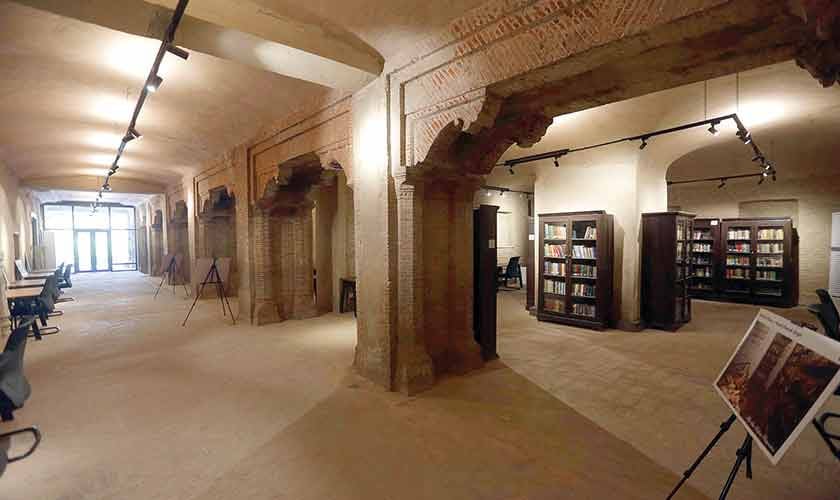A Savvy Traveler’s Journey to Ireland: A 1953 Family Expedition from Rural Minnesota
In 1953, my father, a savvy traveler from rural Minnesota, packed a portable 35mm camera, Kodachrome slide film, and other essentials, preparing for what would become a remarkable journey to the island of Ireland. My late father, Martin J. Walsh Jr.—nicknamed Marty to avoid confusion with his father, Martin J. Walsh Sr.—made our family’s first known return trip home to Ireland that year. He documented his adventures with Kodachrome film and a Clarus 35mm camera, preserving vivid memories of this meaningful expedition.
### A Minnesota Native with Deep Irish Roots
Born in Murdock, Minnesota, in 1924, my father was 28 years old in 1953 and worked as a railroad telegrapher, communicating via Morse code for the Great Northern and Burlington Northern Railroad. He continued his career with the railroad from 1943 to 1984, experiencing a company name change to Burlington Northern Railroad during his tenure.
Our family’s roots trace back to a predominantly Irish immigrant settlement in De Graff, a small village in rural Swift County, Minnesota. Our ancestors arrived in the late 1800s as part of a larger migration driven by Saint Paul Archbishop John Ireland. Between 1875 and 1885, Archbishop Ireland helped resettle approximately four thousand Irish Catholic families—including ours—from urban slums to rural farmlands across ten villages in five western Minnesota counties.
Growing up, my father often shared stories about our family history and connection to Ireland, proudly declaring, “We are Archbishop John Ireland’s people.” It was a poignant observation, especially since the Archbishop’s last name mirrored that of the country our family left behind during the mid-1800s.
Today, I live just three miles from De Graff in Murdock, Minnesota—the very house where my father was born nearly a century ago. For those interested in our heritage, more information about De Graff and the historic Church of St. Bridget is available on the United States Department of the Interior, National Park Service website. The Library of Congress in Washington, DC, also hosts a detailed presentation on Irish-Catholic immigration to America, providing rich context for our story.
### Preserving Memories Through Kodachrome
Although my father did not pursue a career in photography, his incredible 1953 Kodachrome images remain intact today, offering a rare glimpse of his travels to Ireland. His passion for travel and photography was passed down to my brother, Paul M. Walsh, and me—both of whom forged careers in photojournalism and media.
Thanks to his meticulous documentation with his 35mm camera, I have been able to learn more about my father’s journey and his experiences abroad. You can explore more of Martin J. Walsh Jr.’s photographs of Ireland on [Flickr here](#).
### Preparing for the Trip of a Lifetime
I imagine my father as a proud young man, eager to see the homeland of his ancestors. One of his Kodachrome slides from May 16, 1953, bears the note, “My pockets full,” hinting at the important travel items he carried. His U.S. passport, issued on February 6, 1953, describes him as 5 feet 11 inches tall, with brown hair, hazel eyes, and no distinguishing marks. His place of birth is listed as Murdock, Minnesota, and his occupation as a telegraph operator.
Though not recorded on his passport, my father often referred to himself as “Black Irish” during my childhood. The term “Black Irish” describes people of Irish descent with dark hair and eyes—often linked to a theory suggesting Spanish lineage from shipwrecked traders. Despite his fair complexion and freckles—markers of rare red hair genes—he embraced this intriguing identity. You can read more about this fascinating theory [here](#).
Not yet married, my father likely lived at home with his parents to save money for this extraordinary journey to Ireland, England, and France, with a stopover in Canada. Traveling to Europe became more accessible after World War II, and according to my grandfather’s diary, my father departed Minnesota by train from Willmar before ultimately flying to Belfast, Northern Ireland.
### A Transatlantic Adventure
During his travels, American Express offices facilitated correspondence between my father and his family back home. His letters include updates from his mother and news from Murdock, including details from the local Catholic parish.
His transatlantic flight included a refueling stop in Gander, Newfoundland, Canada—a vital waypoint for early postwar flights to Europe. Interestingly, the airport in Gander later served as a designated alternate landing site for NASA’s Space Shuttle program, highlighting its strategic importance.
For my father, flying from rural Minnesota—a land of prairies and open farmlands—must have felt like traveling to space.
### Exploring Ancestral Lands in Ireland
My father’s Kodachrome slides capture breathtaking scenes from his Irish adventure, including a trip to Killarney in County Kerry—one of our family’s places of origin in Ireland. He did not have the opportunity to find the specific family farm I later discovered in 2018, located in the townland of Dromkerry, County Kerry. This area boasts stunning views of the Gap of Dunloe, the Lakes of Killarney, and the majestic MacGillycuddy’s Reeks and Purple Mountain ranges.
His photos include a three-hour pony and trap ride through the Gap of Dunloe and the Lakes of Killarney, as well as images of the railway station, mountain landscapes, and rural countryside scenes.
One particularly memorable shot is labeled “Marty Walsh. Taken in Saint Stephen’s Green, Dublin. It was taken after a rain.” He stayed across from this famous Dublin park at the Shelbourne Hotel and even captured views from his hotel room window overlooking the green.
### Touring Ireland and The Quiet Man Connection
He traveled extensively by train and bus throughout Ireland, visiting cities such as Dublin, Galway, and Limerick. His slides reference locations connected to the classic 1952 film *The Quiet Man*, starring John Wayne, Maureen O’Hara, and Barry Fitzgerald—filmed in Galway and surrounding areas.
His images include John Wayne’s house and other film-related sites. It’s tempting to suggest that *The Quiet Man* may have inspired or fueled my father’s desire to explore Ireland and connect with his ancestral roots.
In January 2019, I had the unique experience of watching *The Quiet Man* from my room at the Shelbourne Hotel—something my father likely never imagined possible during his 1953 trip. My view wasn’t of Saint Stephen’s Green but rather of the hotel courtyard and the Irish flag waving from the rooftop, reminding me of the passage of time and the enduring connection of our family to Ireland.
—
### About the Author
Jannet L. Walsh, of Murdock, Minnesota, is a photographer, writer, and educator. She is the author of the forthcoming creative nonfiction quest narrative *Higgledy-Piggledy Stones: Family Stories from Ireland and Minnesota*, scheduled for publication in 2022 by Shanti Arts Publishing.
Jannet has also compiled the *Irish Genealogy Toolkit*, a comprehensive list of resources for those researching Irish roots. You can follow her on [Facebook](#) and [Twitter](#).
*Originally published in 2022, updated in September 2025.*
https://www.irishcentral.com/opinion/others/ireland-images-kodachrome



